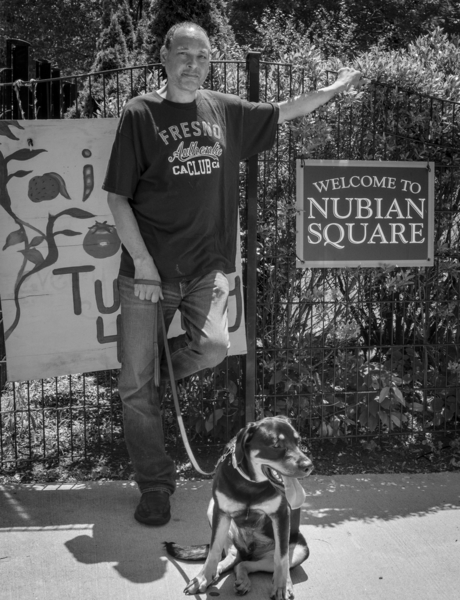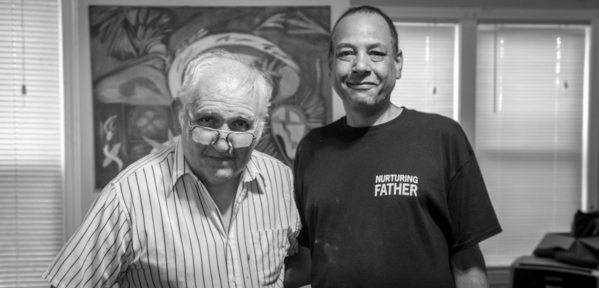“I’m scared of what the future holds, of getting old. I don’t have a family, and once I retire, I won’t have anything to distract me from the fact that I’m alone in this world.”
I wasn’t sure how to respond, because he was telling the truth: that his work is what helps him avoid the painful memories of his past. I could only offer him a tissue, which he already had at his side. Clearly he was more prepared for this interview than I. So I kept filming. After all, it’s what he asked me here to do.
I met Richard several years ago in Atlanta at a conference, where we presented together on a panel focused on fatherhood programs. I showed clips of my film, THE BLACK FATHERHOOD PROJECT, and he discussed one of his programs at the Boston Public Health Commission, the Father Friendly Initiative. Months later he invited me to Boston to show my film to the dads in his program and the larger Boston community. He was a great host and we bonded over our shared passion for social justice and fighting for opportunities for Black men.
Last year he reached out to me with excitement about a new program he was expanding that would provide housing for homeless dads, essentially instilling a safety net to prevent kids from going in to the foster care system, and help those in the system get out of it by reuniting them with their dads. He asked if I could make a film about it. I said yes, because I knew that for Richard, this is more than just a critical service to offer dads; it represents his life coming full circle.
I sit with Richard in his living room. He lights a cigarette, sitting criss-cross at the end of his sofa, rocking back and forth, watching talking heads on CNN. He tells me the rocking keeps him calm, and he also rocked himself to sleep throughout high school. It’s been that way as long as he can remember.
Later, he takes me on a walk in his neighborhood of Roxbury, where he’s lived for over thirty years and shows me what he calls “his bubble.” With his teenage puppy Benny, we trek the 15 or so block radius where he eats, works, and breathes. The streets are colorful in its people, structures, and sounds. African American, Puerto Rican, Cape Verdean, Dominican and other music, accents, and culinary scents converge here brilliantly. And Richard, who told me he has struggled with his own racial identity in the past, seems to fits right in.
While in college, after passing the birth records section day after day at the Boston Public Library where he studied, he decided it was time to seek… something. Information? Apologies? Reasons? Family? Love?
Her name was listed with an address in the North End, a predominately Italian-American neighborhood in Boston. Calling the number he found in the phone book next to the name of his birth mother;s father, a man answered:
Hi, I’m trying to reach “Lynn DeRosa.”
“My daughter’s been dead for seven years, who the hell is this?”
“Well, uh, actually I’m her son she gave up for adoption.”
The man on the other line, Richard’s grandfather presumably, sputters out angry words, denying Richard’s truth. Eventually, a woman gets on the line.
“Is your name still Richard?”
Briefly, Richard feels some relief at the confirmation that he did dial the right home. But the denial continues, upset and accusatory, and the conversation ends, but not before Richard leaves his number in case they change their minds later.
A second brief phone call take place, and it ends with Richard being told, “There’s no niggers in this family.”
The ultimate rejection of family reunification, that perhaps he fantasized for years going entirely differently, in addition to learning of his mother’s death, pushes Richard to lock himself in his dorm for days alone, drowning in tears.
It was, without a doubt, an incredibly traumatizing experience. Yet it was only the latest of many. First, there was being returned in his infancy by his adoptive parents to the Department because he skin was darkening. Later he learned his first adoptive parents weren’t informed he was a biracial child.
There were the Sunday beatings from the Hendersons. The constant hard labor the Turner family forced upon him. Being locked in a dark basement for hours. The fighting and yelling at the Garcia’s house. And the feeling of denial, each and every time he was sent back, as if he came with a warranty. By the time Richard was 14 years of age, he had been placed in eight different living situations.
Of course, the adoptive parents had their reasons, as is documented in his records. “Steals money from neighbors.” “Pees in the bed.”
“Hides candy all over the house.” “Wouldn’t stop rocking his bed and broke it.”
“Breaks his sibling’s toys.”
As he reads aloud the complaints from his case file, we can’t help but get a good laugh out of it. It’s the typical behaviors of a child, especially one with a traumatic history of abuse and neglect.
I ask Richard why he so adamantly wanted to make a film about his new program, and his life journey.
“Because I have a hard time getting close to people, I don’t have a family, or a legacy in that way. I want to leave something tangible behind after I die that helps young people. This film is what I can leave behind.”
While he is no longer a petty thief or household menace, he says he is suffering from more serious issues that are likely the result of his childhood. He recently had an operation to remove a cancer in his colon, however after a CAT scan legions were discovered on his left lung and due to complications during a biopsy he was put into a medically induced coma for two days. In addition to the cancer he has other serious health issues under examination. Research has shown that adverse childhood experiences like those he experienced can be directly related to health problems such as cancer, heart disease, and substance abuse. To him, the correlation is clear, and it should be included in the film.
“I want to show that my problems haven’t gone away completely. I want to show the whole truth, not just the good stuff, because it’s not that clean and simple. My childhood is still impacting me and showing itself in new ways.”
I concur, and see tremendous value in telling his story in all of its complexity, triumphs and shortcomings. It’s the truth, and that’s where healing begins.







Comments (9)